The necessity for a heavy lift drone is rather prevalent because of many enterprises worldwide.
Fortunately, technology has progressed to the point where drones are no longer delicate aircraft incapable of hauling large payloads.
As you can see from our post, there are an increasing number of drones that can carry large objects.
To begin with, there is no one answer to the issue of how much a drone can lift.
This is a fast-paced sector where new records are set every day. We created a current list of heavy lift drones at the bottom of the page, all of which can carry a human (or a couple of them).
Of course, these aren’t consumer drones, and the list is meant to be entertaining rather than a buying guide.
Drones are now incredibly valuable tools in the filmmaking and search and rescue industries. Drones can now travel around skyscraper-filled cities and wide vistas like canyons while recording in 4K.
Many people believe that drones are incapable of carrying a hefty camera for photography.
They are, however, incorrect. Modern UAVs aren’t only for GoPros and other action cameras, and there’s a powerful drone out there that can lift the hefty camera.
You may use this function to shoot beautiful aerial footage. Many professionals and even amateurs quickly discovered that they require more than a GoPro camera, where a heavy lifting quadcopter comes in handy.
You can easily take the most magnificent photographs and gorgeous videos with any high-end camera and videography camera.
It is vital to note that such strong drones have a large lift capacity and can haul other heavy things and cameras.
The flying time decreases due to a battery charge as the weight carried rises. The flying time has remained constant for a normal consumer drone at roughly 25-27 minutes.
If you acquire a big multi-copter or a UAV with a hefty payload, you can shorten your flying duration in half.
This, though, can turn out to be a necessary evil. When it comes to capturing amazing films, many flyers have realized that you can do a lot in a 13-minute timeframe.
Here are 7 of the best heavy lift drones that we thought deserved to be highlighted.
But how much weight can a drone transport?
The multicopters on our list can carry up to 20 kg of weight. On the other hand, a quadcopter can only carry about 1 kilogram.
Drones that can carry objects are hard to come by at a low cost; most of them cost $500 or more.
Table of Contents
Top 7 Best High Payload Drones For Delivery & Transport
DJI Matrice 600 Pro
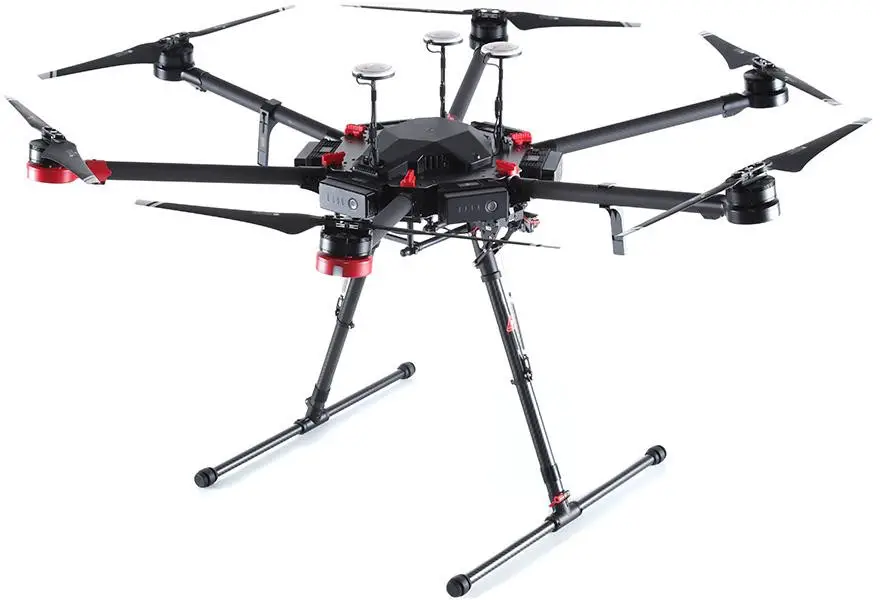
6kg payload
The DJI Matrice 600 Pro Drone is built to withstand a lot of use. It is highly long-lasting and requires very little upkeep. The M600’s body is aluminum, and its landing gear can be manually retracted.
It also includes folding carbon fiber arms. The landing gear may be retracted to prevent the drone’s legs from being captured on camera.
The drone’s folding arms make it sturdy and portable. It has six carbon fiber propellers that provide the drone with much-needed thrust for landing and taking off.
The DJI Matrice’s flight is reliable and smooth, thanks to its six actively cooled motors. It also has an E2000 Tuned Propulsion System, consisting of 2170 Propellers and 6010 Motors.
The DJI Matrice can carry enormous payloads and fly thanks to its massive motors and strong propellers silently. Even if one of the drone’s motors fails, the drone can still land safely.
If you get the Matrice 600 Pro, you’ll be able to customize it to your heart’s content.
All DJI gimbals and cameras are compatible, and Zenmuse cameras and gimbals may also be used.
The DJI Matrice 600 Pro does not come with a camera, but it can hold any camera and gimbal, thanks to its heavy-duty capabilities.
It may be used with Zenmuse cameras.
The M600 can fly for up to 35 minutes when fitted with Zenmuse XT and X5. The Matrice can fly for up to 16 minutes if a bigger camera is utilized.
DJI Spreading Wings S900
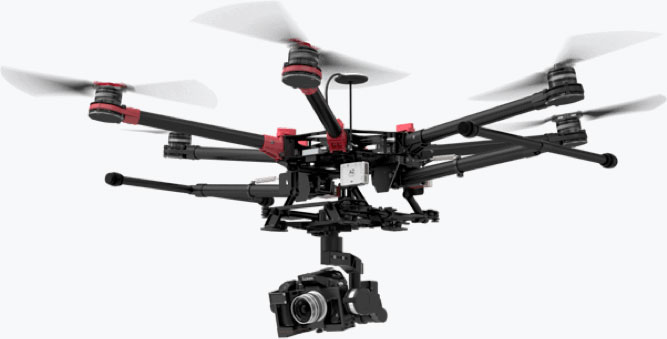
6.8kg payload
Instead of the more common octocopter type for large lift drones, DJI’s Spreading Wings S900 is a hexacopter. This makes this (relatively) small professional drone carry a total payload of over 7kg all the more amazing.
That will cover a wide range of scenarios, so if your payload needs are within that range, you should continue reading.
First and foremost, let’s get one key truth out of the way:
The S900, according to DJI, can carry its maximum payload for 18 minutes before requiring recharging.
Of course, it is under ideal conditions; in reality, I believe the time is closer to fifteen minutes.
Although it isn’t the longest mission duration, most skilled filmmakers don’t need to shoot for much longer.
You should move on if your payload mission takes more than 15 minutes.
Remember that smaller cargo should result in faster flight durations; it isn’t easy to forecast precisely how much time you’ll save, but you may negotiate for a few more minutes if you’re not going to fill the plane.
It could be worth looking at S900 forums to see what pilots with comparable loads receive.
Also, keep in mind that the S900 might come with batteries of varied capacities, which will affect battery life.
Aside from being a remarkably powerful drone, the craft is also extremely light, weighing only 3.3 kg.
It’s also ideal for professionals who don’t have access to a large truck to transport their drones.
The S900 can be folded into a compact form and transitioned from folded to flight-ready in approximately five minutes if you know what you’re doing.
The flight systems on this dog were remarkable when it was first released, and they remain so now.
DJI demonstrated the S900 hovering continuously for 72 hours using an external power source.
So you know there won’t be any overheating or other endurance-related failures during the drone’s 15 minutes in the air.
The only payload this huge drone can carry is whatever fits onto the gimbal’s end-effector unless you’re ready to substantially alter it.
This is the bee’s knees if you want to go into professional aerial photography.
It’s not quite professional after purchasing all of the additional equipment required to make the camera side of it function, but it’s close.
Freefly System Alta 6
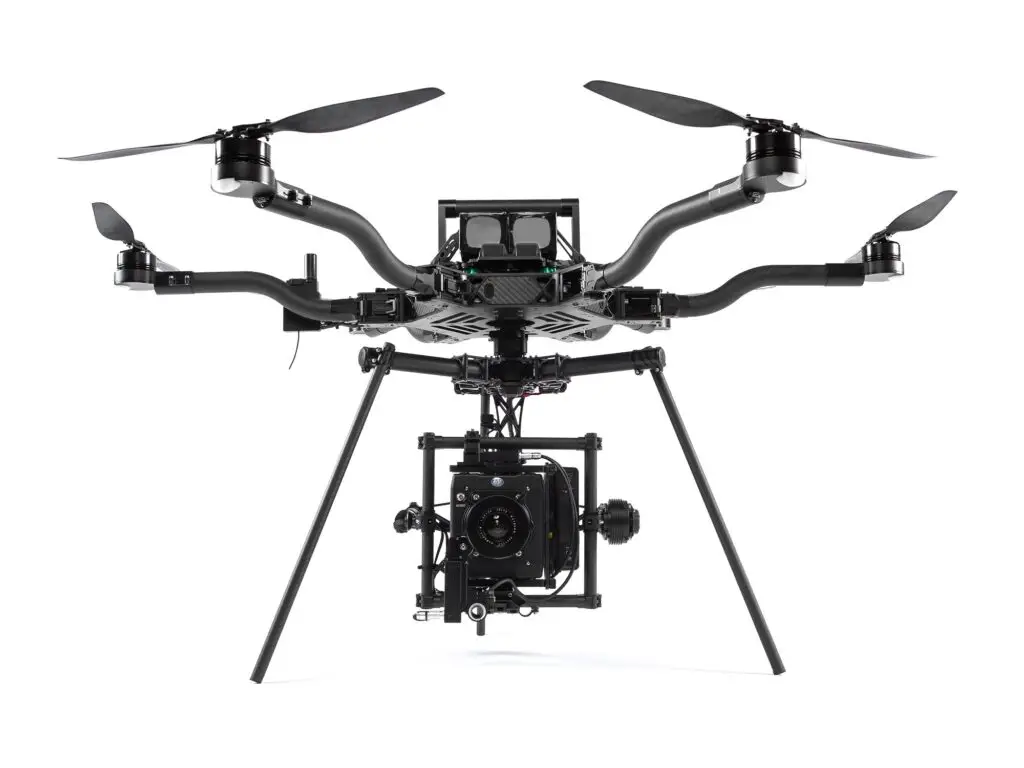
6.8kg payload
The Alta 6 is similar to the Alta 8 but has six instead of eight rotors.
This reduces the payload by a few pounds while still providing sufficient lift for most heavy-lift applications.
Like the Alta 8, this fantastic folding drone has a unique top-and-bottom mounting method and rapid release capabilities.
These new-generation drones are significantly harder, with the ability to withstand more forms of system failure and weather resistance than ever before.
The rest of what I’ve said about the Alta 6 also applies to the Alta 8, so I’m not going to say it again. Instead, continue reading for a summary from the older brother.
Freefly System Alta 8
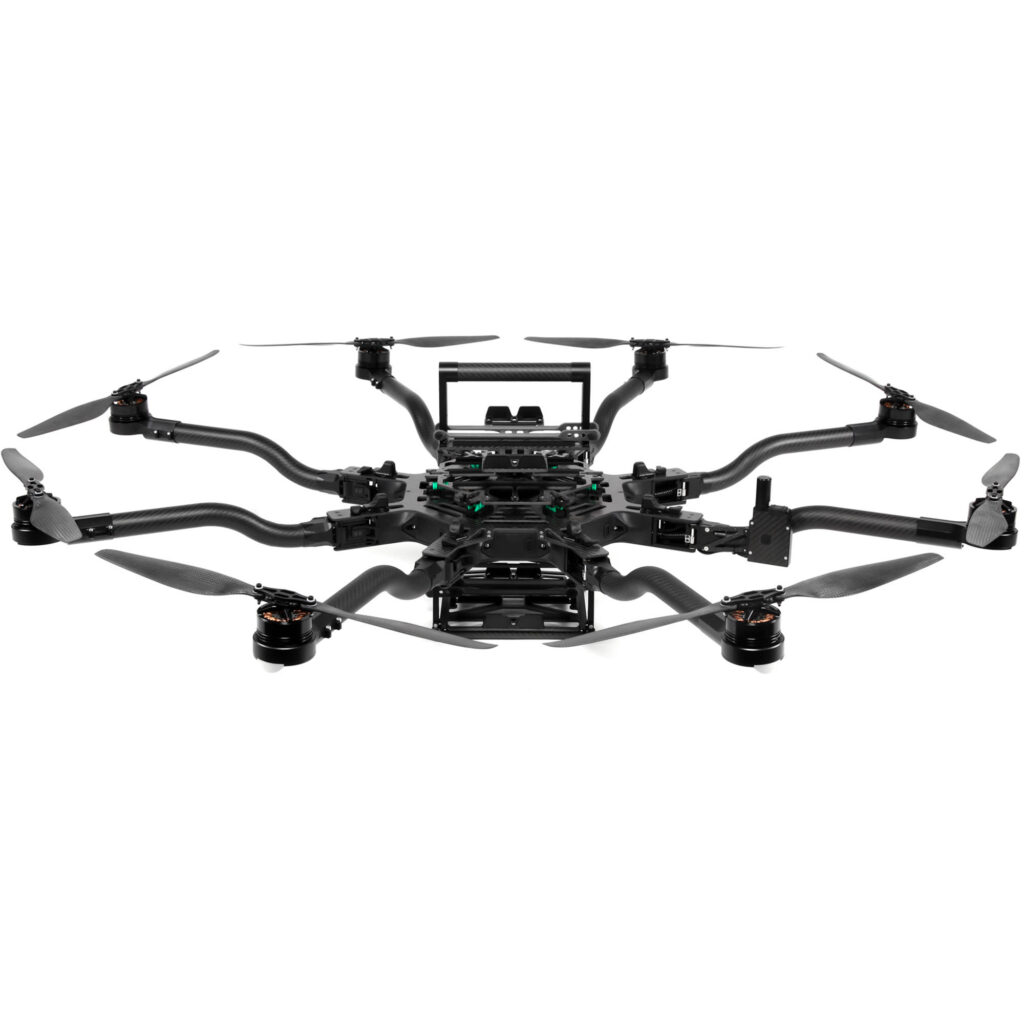
9kg payload
The Freefly Alta 8 is a gigantic machine to look at when unfolded. It seems more like a military attack machine than a camera drone, thanks to its bendy arms and jet-black paint job.
The flexible limbs are part of an amazing folding mechanism that transforms this massive drone into a small device.
The Freefly Alta 8 can be folded to half its unfurled diameter without growing higher. I think it’s clever.
The Alta 8, like the Matrice 600, is part of a new generation of drones that are constructed to a higher degree of redundancy than previous models.
The Alta 8 is even more stunning because each device is thoroughly inspected before leaving the manufacturer.
This raises the cost, but at least you’ll know your new drone is a real flying machine rather than a possible flying machine.
The free-fly offers a fantastic quick-release mechanism that is ideal for professional use when you need to regularly switch out equipment when it comes to camera duty.
Even better, the drone has mounting points on both sides, allowing you to top-mount the camera.
The Alta has also been designed to achieve something that few other drones have attempted: fly in terrible weather.
It won’t survive a tornado, but it won’t be harmed by a little rain, unlike other large drones that would be grounded instantly.
With a full 9kg payload, you’ll get around nine minutes of flying time, but with the 16Ah batteries, you’ll get about 20 minutes.
Unloaded or with extremely light loads, you should expect to last roughly 30 minutes before recharging. Overall, this is a pretty remarkable machine.
DJI Spreading Wings S1000+
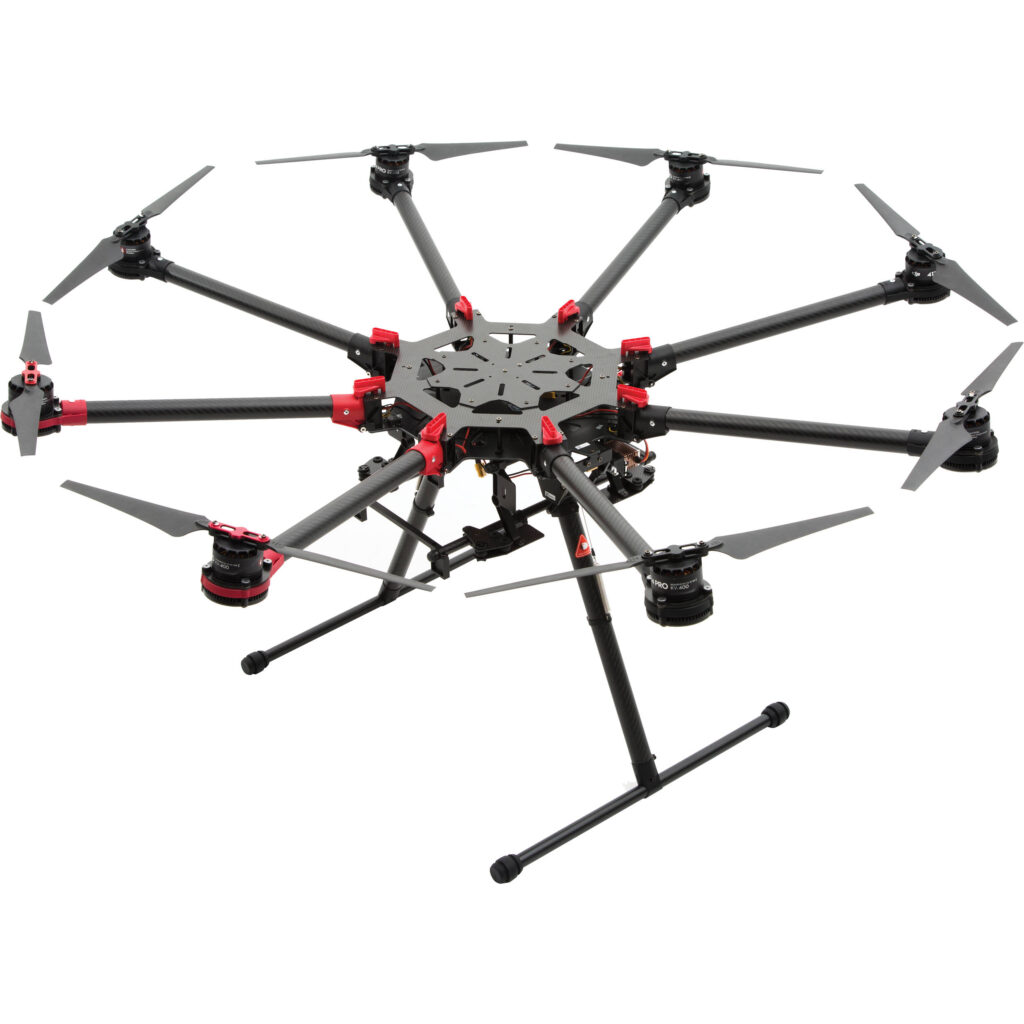
9.5kg payload
The S900’s a bigger, newer, and more powerful brother. The S1000+ increases the payload capacity from 6.8kg to 9.5kg.
If you want to create a drone-based dog food delivery service, that’s almost enough to fly a bag of dog food around.
The fact that the S1000+ is an octocopter is one of the key reasons for its increased capacity.
That’s a total of two more rotors over and beyond the S900’s. Of course, the tradeoff is that this drone isn’t as small as the S900, but that’s to be anticipated.
It also doesn’t have the same flight time as its smaller sibling. A fully loaded S1000+ will last no more than 15 minutes.
It does, however, have the same simple folding method that allows it to be as small as possible.
The S1000+ offers several advantages over the S900 and just about every other drone that employs Zenmuse gimbals. This is one of the few drones that can use any Zenmuse gimbal.
This implies that if you have your heart set on a certain Zenmuse gimbal, this is most likely the platform for it.
The S1000+, like the S900, is designed for professional photography and filming.
This isn’t the kind of drone you’d use for anything other than photography, but it’s one of the smoothest and most dependable platforms for pros looking for footage.
Of course, you could change it, but I wouldn’t advocate it unless you have a lot of money and don’t mind wasting part of it.
DJI Agras – Best AG Drone

10kg payload
The Agras is a significant deviation from DJI’s usual camera drone lineup. The Agras is an agricultural drone, as its name indicates.
The days of spraying herbicides on fields using expensive and risky manned airplanes are long gone.
With this large drone, you can keep humans out of harm’s way while spraying at a lower height, limiting how far the wind carries the toxins.
The Agras has a 10-liter tank and a payload capacity of 10 kilograms.
The Agras can stay aloft for 10 minutes when completely laden. It may not appear to be much, but keep in mind that it only needs to fly aloft long enough to unload its payload.
It also flies low, giving it a huge margin of safety before touching down.
The Agras has revolutionized the agricultural business in the East, where manual foot-powered spraying was formerly the standard.
According to DJI’s marketing movies, this remarkable agricultural sprayer drone has greatly reduced human labor.
Griff Aviation Guardian
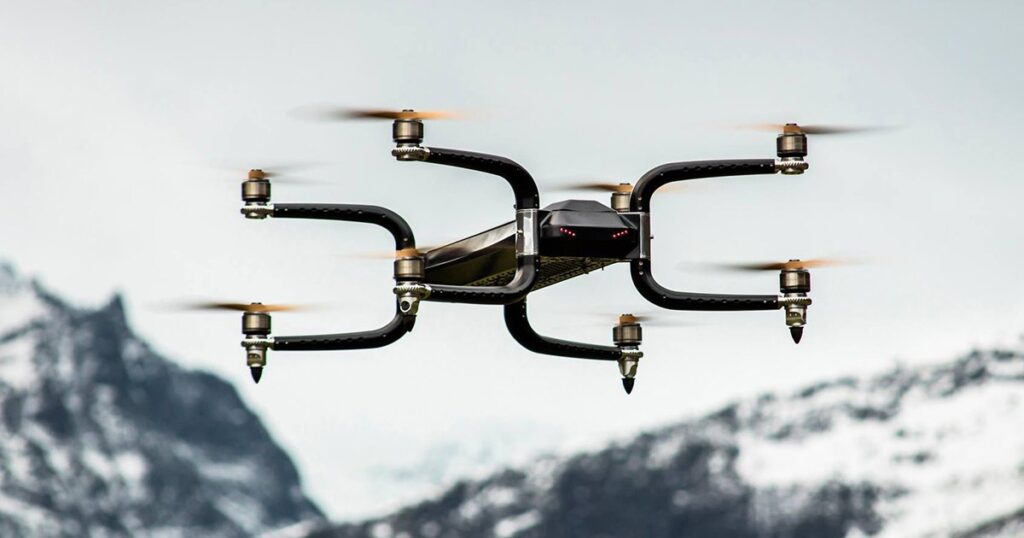
200kg payload
Compared to the other drones here, the Griff Aviation Guardian is in a league of its own. The payload capacity of this gigantic equipment is 200 kg.
The worst part is that the Guardian isn’t even the Griff fleet’s most powerful drone. The Griff 300, with a payload capacity of 300 kg, was revealed towards the end of 2016.
The business intends to deploy an 800 kg payload drone in the future.
The Guardian is meant to carry advanced optical equipment for law enforcement and other safety observation activities. It can fly for around 30 minutes and is water-resistant.
What is the cost? It’s probably too much if you have to ask and aren’t a government department.
It has eight rotors, but each group of four is positioned vertically, giving it the appearance of two quadcopters fused.
Even my chubby buttocks would be no match for this massive industrial drone, and that’s saying a lot!
Quadcopter vs. Hecaopter vs. Octocopter
While quadcopters reign supreme in smaller drones, we’re seeing a growing trend in the large drone sector for drones to require more motor redundancy and power.
Quadcopters
As their name implies, these drones have four motors and are among the most cost-effective and stable drones available.
These are quite light and may be used successfully for carrying lesser payloads for medium-level cinematography production quality, but if you’re looking for a truly heavy-lifting drone, you’ll have to check further down the list.
Hexacopters
Hexacopters feature six propellers and are better suited for heavy lifting and balanced weight distribution, but they come at a cost… literally.
Hexacopters are more expensive because of the additional motors and technology, but they can carry more, fly higher, and have a significant advantage in terms of motor redundancy.
Motor redundancy refers to a drone’s ability to continue flying even if one of its motors breaks completely.
Up to two motors can fail during a flight, and the drone can still fly, although this is dependent on where the failed motors are located.
Octocopters
Octocopters, which have eight propellers and are utilized for some of the most heavy-duty operations in any business, take redundancy to the next level.
While more motors (up to 12) may be fitted onto a drone, this isn’t possible because octocopters get the most value out of the number of motors and dependability.
Octocopters are more powerful and dependable, but they are not always superior to hexacopters in every manner, especially considering the price difference.
Payload Weight & Maximum Takeoff Weight: What Are the Differences?
Operating Empty Weight
The figure in kg that the drone weighs without any cargo, fuel (batteries included), or passengers is known as the OEW. Sensors and mounts for various gimbals are sometimes excluded as well.
Payload Weight
Because the amount a drone can lift off the ground varies, this section is divided into two sections.
- MRP (maximum Recommended Payload) – This payload ensures ideal flying conditions.
- MEP (Maximum Effective Payload) – The maximum payload a drone can lift off the ground.
Maximum Takeoff Weight
This equals the previous two numbers combined (operating empty weight + payload weight).
This refers to the drone’s operational weight and the payload weight, which gives you an estimate of its maximum weight ( depending on how much you prefer loading it and altering its flight characteristics).
Conclusion
So, if you’ve ever wondered how much weight a drone can carry, now you know.
You probably didn’t believe it was conceivable that drones could already carry such a large load.
If this is your first time delving into professional aerial filmmaking and photography, you probably didn’t realize you could take your favorite camera to the skies.
As you can see, virtually any camera can be fitted to one of these high-payload drones. This means you’re not confined to GoPro-style action cameras.
We hope this article has given you a better understanding of what a high-payload drone can do. Have fun flying!
FAQ
What does a heavy lift drone mean?
Many drones that have become highly popular among pilots who capture film and fly for fun can carry payloads ranging from 2-4 lbs.
By most measures, you’re looking at anything over 10 lbs. once you get into the “heavy lift” area.
Some of the top consumer-level heavy lift drones can handle more than 40 pounds, and Griff Aviation, a Norwegian firm, just launched a drone that can carry more than 400 pounds!
How much weight can a drone carry?
A popular drone like the DJI Phantom 4 can carry 1.02 lbs as a safe and daily payload.
While this may not seem like much, the Phantom 4’s primary function is picture capture, which requires less technology.
Other drones, such as the Alta 8, can carry up to 15 pounds, putting them firmly in the “aerial dolly” or “lugging” category.
How long can drones fly?
For a long time, the flight duration of a typical consumer drone has been locked at around 25-27 minutes.
If you buy a large quadcopter or a UAV with a hefty payload, your flight duration will be cut in half, but you will be able to achieve considerably more in terms of moving cargo or machines.
What does take-off weight mean?
The highest weight at which the aircraft has been proved to handle all of the airworthiness standards relevant to its flight is the take-off weight.
This is always a factor to consider because it significantly impacts how your craft performs in the wind, how long the battery lasts, and overall sturdiness.
Can drones lift people?
Yes, if they’re powerful enough, drones can carry people. So far, this has been accomplished in two ways: by putting the person inside as if it were a car or by raising someone through a cable.